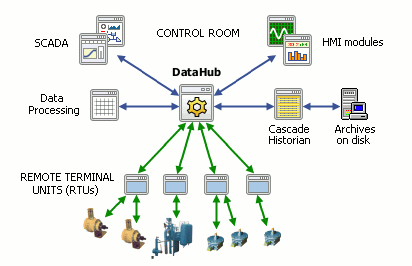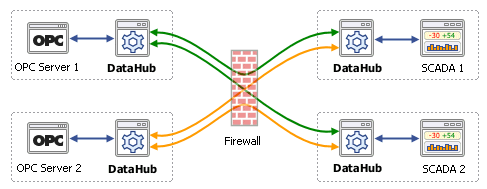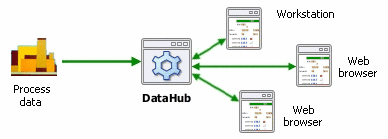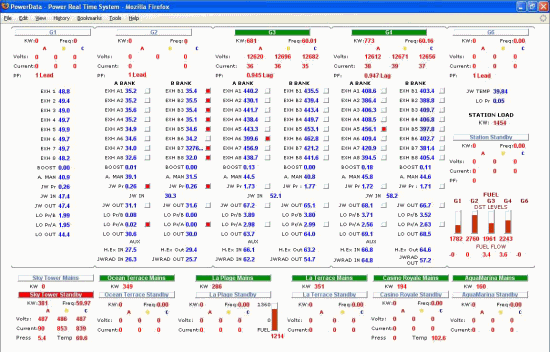New technologies such as Software as a Service, the Internet of Things and cloud computing for industrial process temperature bring new challenges, but there are solutions.
Interest in using cloud computing — also known as Software as a Service (SaaS) — to provide remote access to industrial systems continues to rise. Vendors and company personnel alike point to potential productivity improvements and cost savings as well as convenience. Operators and plant engineers may want to receive alarms and adjust heating controls while moving around the plant. Managers would like to see production data in real time — not just in end-of-shift or daily reports. Hardware vendors could benefit from getting live readings from their installed equipment for maintenance and troubleshooting operations.
Some industrial processors are attempting to provide this kind of window into their production systems. Yet, many question the wisdom of opening up a plant’s mission-critical control network to the possibility of malicious attack or even misguided errors. With a proper understanding of what is at stake, what is being proposed and how it can best be implemented, you can better decide whether remote access to your production data could benefit your company.
Security First for Industrial Networks
When talking about remote access to plant data, the first concern is security. Any approach that exposes the control system to unauthorized entry should be off the table. One popular approach is to secure the network against any potential intruders and open it only to trusted parties. Connections into the plant typically originate from smartphones, tablets, laptops or desktop computers. These systems usually are running a human-machine interface (HMI), remote desktop application, database browser or other proprietary connector.
In most cases, the plant engineering staff or IT department can grant client access to the network via a virtual private network (VPN), so authorized users can get the data they need. However, a typical VPN connection provides link-layer integration between network participants. This means that once on a network, an outsider has access to all other systems on the network. Thus, the company must either fully trust each person who comes is granted access to the network, or the company must task the IT manager with securing and protecting the resources within the network.
It would be unwise to risk giving visitors full access to everything that a VPN exposes. Using a VPN this way is a little like having a visitor come into your plant. Suppose a service technician arrives at the gate saying he needs to check a piece of equipment. You could just tell the guard to check his credentials, and if he checks out, give him a hardhat, directions and send him in. That is the limited-security approach. A better way would be to provide a guide to ensure that the technician finds his destination, does his work and leaves with only the information he came to get. It takes more effort and planning, but if you are going to allow someone to enter the premises, such effort is necessary to ensure security.
Better than VPN
An even better approach is to only allow access to the data itself. Consider this: the user of the data — be it vendor, customer or even corporate manager — does not need access to the whole network. Instead, they just need the data. So, rather than allowing a client to log on via a VPN connection while the IT manager works to secure confidential areas of the network from the inside, wouldn’t it be better to provide access to the data outside of the network altogether?
To continue our analogy, this would be like the guard handing the service technician exactly the data he need he arrived at the gate. There is no need to open the gate and no need to let him into the plant. In fact, the service company, vendor or other authorized party could request the data be sent to their own location, so they do not even have to go to the plant in the first place. This approach to remote monitoring is far more secure.
Is such a scenario realistic? Yes, if you use the right technology in the right way. For example, WebSocket is a protocol that supports communication over TCP, similar to HTML. But unlike HTML, once a WebSocket connection is established, client and server can exchange data indefinitely. The protocol also supports SSL encryption, a well-tested security protocol. Thus, WebSocket technology can be used to open and maintain a secure data tunnel over TCP from a plant to a cloud server without opening any ports in any firewalls. Once the tunnel connection is established, data can flow bi-directionally.
Isolating the Industrial Process Data
Such a data-centric approach to remote monitoring and supervisory control has several benefits. One key advantage is that the process can run in complete isolation from the remote client. Low-level control — and, in fact, all systems within the plant — remain completely invisible to the remote clients. The only point of contact for the remote client is the selected data set being streamed from the plant, and that data resides in the cloud.
While nobody seriously imagines making low-level control changes over a cloud connection, a solution based on WebSocket technology could allow both read-only and read/write client connections for those applications where remote changes are deemed acceptable. Authorized personnel then would have the ability to effect change in plant processes for diagnostic or maintenance purposes via a secure connection. This approach would not require any open firewall ports, so the plant remains invisible to the Internet.
Regardless of the intended use of the data, a correctly provisioned WebSocket connection to the cloud provides the process isolation needed to provide access to data without jeopardizing your in-plant systems.
Any Data Protocols
Another advantage to this approach is that it can be protocol-agnostic. Ideally, the system would carry only the raw data over TCP in a simple format: name, value and timestamp for each change in value. The connector would convert the plant protocol, such as OPC or Modbus, to a simple data feed to the cloud. Requiring a minimum of bandwidth and system resources, the data would flow in real time to all registered clients.
Each client, in turn, can convert the data into whatever format is most convenient and appropriate for their application. Options include spreadsheets, databases, web pages or custom programs.
Better yet, this approach to remote monitoring is not necessarily limited to in-plant connections. Custom-developed WebSocket connectors small enough to fit on embedded devices such as temperature sensors or flowmeters could be placed at remote locations any distance from the plant. Then, by wired or cellular connections to the Internet, the devices would connect directly to the cloud via WebSocket tunnels, without going through the traditional SCADA system, if need be. Such high-performance connectivity would support secure, real-time M2M communications and meet essential requirements of the industrial Internet of Things (IoT).
Changes and Challenges
However you look at it, change is on the horizon for industrial process control systems. The current state of the art for networked control systems was made possible by dramatic technical breakthroughs in the 80s and 90s. Many industry experts say that we are now on the verge of similar breakthroughs in remote monitoring and supervisory control. Whether they call it cloud computing, Software as a Service (SaaS), Industry 4.0 or the Industrial Internet of Things (IIoT), most will agree that the biggest challenge right now is security.
New technology provides new capabilities, and it also presents new demands that may challenge our way of thinking. Accessing data from a plant or remote sensor halfway across the world needs a different approach to security than our current models were designed for. Yet, there is no need to remain attached to the status quo if it does not truly meet the needs. These are engineering problems, and there are engineering solutions.
Bob McIlvride is the director of communications with Skkynet Cloud Systems Inc., Mississauga, Ontario, Canada. Skkynet provides secure cloud-service remote monitoring services and can be reached at 888-628-2028 or visit the website at http://skkynet.com.







